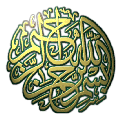
SUFI ORDER-TARIQAT GUL NUR JIHANIYYA
RADIANT VALLEY ASSOCIATION
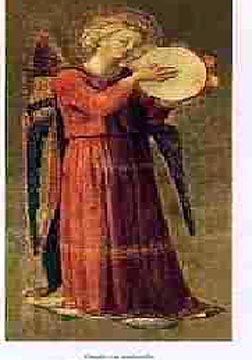
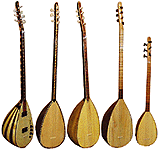 BUZUQ-SAZ-stringed instrument, the name of it comes from Turkish meaning "bashi" name given to the Ottoman troops literally meaning "burnt head or uprooted." This instrument is an essential one in Rakbani style of religious music, it is a hybrid instrument of it's larger relative the deeper-toned saz, and is compared to as viola/violin in modern Western instruments. A long-necked fretted string instrument, the buzuq-saz is made with two metal strings which are played with a plectrum-pick, having an metallic lyrical resonance of sounds.
BUZUQ-SAZ-stringed instrument, the name of it comes from Turkish meaning "bashi" name given to the Ottoman troops literally meaning "burnt head or uprooted." This instrument is an essential one in Rakbani style of religious music, it is a hybrid instrument of it's larger relative the deeper-toned saz, and is compared to as viola/violin in modern Western instruments. A long-necked fretted string instrument, the buzuq-saz is made with two metal strings which are played with a plectrum-pick, having an metallic lyrical resonance of sounds. |
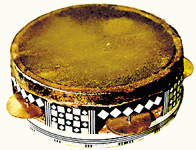 MIZAR-DAFF-a name for a type of popular instrument called a tamborine. It consists of round wooden frame, covered on one side with tight fitting goat or fish skin. Pairs of brass metal discs that are set into niches carved in frame, to provide the jingle sound when struck by hand, The sounds of this percussion instrument set the rythum of the music, particularly
in the religious performances of Islamic classical styles
of Islamic religious music.
MIZAR-DAFF-a name for a type of popular instrument called a tamborine. It consists of round wooden frame, covered on one side with tight fitting goat or fish skin. Pairs of brass metal discs that are set into niches carved in frame, to provide the jingle sound when struck by hand, The sounds of this percussion instrument set the rythum of the music, particularly
in the religious performances of Islamic classical styles
of Islamic religious music. |
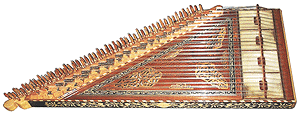 KANUN-QANUN
is a decendent of old Egyptian harp and has played an integral part in Islamic religious music since 10th.,century. A kind of zither-dulcimer, its Arabic name which means 'rule' or 'law'. The qanun-kanun was introduced to Europe by the 12th., century and came to be known during 14th-16th., century as a psaltry. The form of a qanun-kanun consists of a trapezoid-shaped flat board, over it spread 81 strings which are attached in groups of three with 25 treble chords to each note. The instrument is placed flat on knees or small table in front of musician the strings are plucked with finger-plectra-picks, one plectrum attached to the forefinger of each hand. More than any other type of instruments of
Islamic music, qanun-kanun is suitable for display of virtuosity,
and execution of fioture and rapid scales. this traditional instrument
had been replaced by less complex harpsichord, exchanged with zither's
plectra-picks with hammers which grew into the piano a percussion instrument. KANUN-QANUN
is a decendent of old Egyptian harp and has played an integral part in Islamic religious music since 10th.,century. A kind of zither-dulcimer, its Arabic name which means 'rule' or 'law'. The qanun-kanun was introduced to Europe by the 12th., century and came to be known during 14th-16th., century as a psaltry. The form of a qanun-kanun consists of a trapezoid-shaped flat board, over it spread 81 strings which are attached in groups of three with 25 treble chords to each note. The instrument is placed flat on knees or small table in front of musician the strings are plucked with finger-plectra-picks, one plectrum attached to the forefinger of each hand. More than any other type of instruments of
Islamic music, qanun-kanun is suitable for display of virtuosity,
and execution of fioture and rapid scales. this traditional instrument
had been replaced by less complex harpsichord, exchanged with zither's
plectra-picks with hammers which grew into the piano a percussion instrument. |
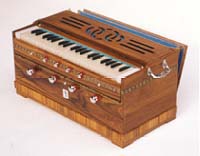 HARMONIUM- are hand made musical instruments of stained, polished wood akin to the early pump-organ with keyboard and is played with right or left hand fingers while pumping bellows with the other hand. These instruments give amazing good sound. Their mellow, warm sounding tones blend well with human voices. These wood hand-crafted instruments come in varied sizes, and with its own unique sounds and styles, with differences in volumes, tonations, playing charecteristics, and each has its own individual scales, stops, bellows, and octave couplers, and these instruments are also prized for thier harmonious blends of graduated sounds in Islamic devotional music.
HARMONIUM- are hand made musical instruments of stained, polished wood akin to the early pump-organ with keyboard and is played with right or left hand fingers while pumping bellows with the other hand. These instruments give amazing good sound. Their mellow, warm sounding tones blend well with human voices. These wood hand-crafted instruments come in varied sizes, and with its own unique sounds and styles, with differences in volumes, tonations, playing charecteristics, and each has its own individual scales, stops, bellows, and octave couplers, and these instruments are also prized for thier harmonious blends of graduated sounds in Islamic devotional music. |
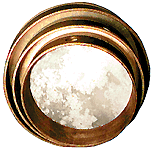 BANDIR-TAR-is framed wood hand drum with goat skin stretched over one side,this drum has great resonance of graded sounds, loudest being close too rim of drum,with progression toward center of drum being dullest sound like a beating heart. Drums are various sizes,having niches cut into one side of wood-frame as tumb-rest,some have small hole for thumb-rest insert. One hand holds drum resting in palm of hand, leaving four fingers for secondary beats on surface of rim. The main beats come with other hand beating surface of drum. Each hand-beat on surface of drum keep tones simulating rythumic heart-beats in Islamic religous spiritual music. BANDIR-TAR-is framed wood hand drum with goat skin stretched over one side,this drum has great resonance of graded sounds, loudest being close too rim of drum,with progression toward center of drum being dullest sound like a beating heart. Drums are various sizes,having niches cut into one side of wood-frame as tumb-rest,some have small hole for thumb-rest insert. One hand holds drum resting in palm of hand, leaving four fingers for secondary beats on surface of rim. The main beats come with other hand beating surface of drum. Each hand-beat on surface of drum keep tones simulating rythumic heart-beats in Islamic religous spiritual music.
|
 OUD-UD-literally means 'branch of wood" from the sambucus tree, it wa used between 6th-10th.,centuries, the instrument had only four strings; a fifth was added by Zitiab a famous musician, a 6th, string was added later in 15th., century. Shaped like a half pear with a short neck, oud-ud is 6 sets of 2 stringed instrument played with a plectrum-pick, often a trimmed eagle's feather, producing a deep and mellow sound.Used by Virtuosos all across the Islamic countries. And is referred to as the 'king' of all fretted instruments in Islamic religious music. The English word for oud-ud is lute which is derived from Spanish word 'laud' which originally came from the Arabic word al-oud.
OUD-UD-literally means 'branch of wood" from the sambucus tree, it wa used between 6th-10th.,centuries, the instrument had only four strings; a fifth was added by Zitiab a famous musician, a 6th, string was added later in 15th., century. Shaped like a half pear with a short neck, oud-ud is 6 sets of 2 stringed instrument played with a plectrum-pick, often a trimmed eagle's feather, producing a deep and mellow sound.Used by Virtuosos all across the Islamic countries. And is referred to as the 'king' of all fretted instruments in Islamic religious music. The English word for oud-ud is lute which is derived from Spanish word 'laud' which originally came from the Arabic word al-oud. |
 DURNEY-which literally means 'dual' in Arabic, is a double pipe-reed later became an clarinet which was popular instrument used in Islamic religious music, and its equivalent is known as the North African maqrum.
DURNEY-which literally means 'dual' in Arabic, is a double pipe-reed later became an clarinet which was popular instrument used in Islamic religious music, and its equivalent is known as the North African maqrum.NEY-is a single reed-pipe with rich long mournfull sound,and comes in many lengths with octaves higher/lower, and are simple hand-made instruments by the Lakmids-Persians. Both these instruments are played by blowing gently through a circular opening at one end, and by manipulating the holes down front of pipe tubes in order to produce specific sounds. In good performance the sounds are well reflected by the musical dialogue between moods of modes. Another similar relative is the minjarah, an open-ended small reed-flute played in the same manner as these reed-pipes. |
 DUMBEK-TABLAH is a membranaphone with goat or fish skin stretched over top of a vase shaped form with hollow opening in smaller end, it is usually made of baked ceramic or metal with intricate designs or plain. When played it is put bewtween the legs or hung with strap to shoulder leaving both hands free to beat top of skin on drum. The hands beat the rythum with hard short with inbetween beats which keeps well blended in the Islamic spiritual music hymns. A is smaller version which is long and slender that is placed on top of shoulder and played with one hand. DUMBEK-TABLAH is a membranaphone with goat or fish skin stretched over top of a vase shaped form with hollow opening in smaller end, it is usually made of baked ceramic or metal with intricate designs or plain. When played it is put bewtween the legs or hung with strap to shoulder leaving both hands free to beat top of skin on drum. The hands beat the rythum with hard short with inbetween beats which keeps well blended in the Islamic spiritual music hymns. A is smaller version which is long and slender that is placed on top of shoulder and played with one hand.
|
